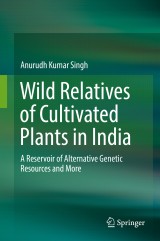Details

Wild Relatives of Cultivated Plants in India
A Reservoir of Alternative Genetic Resources and More|
149,79 € |
|
| Verlag: | Springer |
| Format: | |
| Veröffentl.: | 14.08.2017 |
| ISBN/EAN: | 9789811051166 |
| Sprache: | englisch |
Dieses eBook enthält ein Wasserzeichen.
Beschreibungen
<p>This book provides a comprehensive overview of the wild relatives of crops and cultivated species found in India, covering their distribution, phylogenetic relationships with cultivated species, traits that are of economic and breeding value, and the perceived threats. It highlights the opportunities the wild relatives of cultivated species offer in terms of new genes and allelic variability, as well as several other exploitable economic and environmental benefits that can be harnessed with their conservation and cultivation. This helps facilitate their use – both directly and as part of the breeding program for related cultivated species, filling the gaps of genetic variability in the primary gene pool. It also discusses how they can be used in breeding programs using conventional technologies and the biotechnological approaches of recombinant DNA. Transfer of natural genes using recombinant DNA, known as “Cisgenesis,” can accelerate the process of incorporating these natural geneswithout genetic drag of undesirable features and biosafety concerns, and beyond taxonomic boundaries, in response to the demand for new cultivars to meet the challenges of climate change and ever-growing human population.<br></p><p></p>
<p>Chapter 1. Introduction.- Part 1. Wild Relatives.- Chapter 2. Defining Wild Relatives.- Chapter 3. Importance of Wild Relatives as Genetic Resource and Otherwise.- Part 2. Wild Relatives Distribution and Diversity in Different Crop Groups.- Chapter 4. Cereals.- Chapter 5. Grain Legumes.- Chapter 6. Oilseeds.- Chapter 7. Fiber Crops.- Chapter 8. Forages Crops.- Chapter 9. Vegetables.- Chapter10. Fruits and Nuts.- Chapter 11. Species and Condiments.- Chapter 12. Commercial Crops (sugarcane, tea, coffee, rubber etc.).- Chapter 13. Medicinal and Aromatic plants.- Chapter 14. Floriculture Crops.- Chapter 15. Agro-forestry.- Chapter 16. Cottage Industry Crops and Others (Bamboo, arrowroot, reetha etc.).- Part 3. Conservation of Wild Relatives.- Chapter 17. Classification of Wild Relatives to Facilitate Conservation and Gene Transfer.- Chapter 18. Collection Strategies.- Chapter 19.&nbs</p>p;Conservation Strategies.- Chapter 20. Breeding Strategies for Use.- Chapter 21. Future Perspective.<p></p><p></p>
<p>Dr. Anurudh K. Singh was educated at Aligarh Muslim University (1962-1966), Patna University (1969-1972), the Max Planck Institute, Koln, Germany (1986-1987), and Cornell University, Ithaca, USA (1994-1995) has been interested in the wild relatives of crop species since the beginning of his career. For his Ph.D., he worked on their collection, conservation and conducted cytogenetic studies to trace the phylogenetic relationships between wild species related to Cucurbit vegetable crop species. More significantly, from 1978-1997, while at International Crops Research Institute for the Semi-Arid Tropics (ICRISAT), he was involved in a project on utilizing wild <i>Arachis </i>to genetically improveme cultivated groundnut, and successfully incorporated foliar diseases resistance and other desirable traits from several wild diploid <i>Arachis</i> species. Later, he became involved in the collection and conservation of groundnut germplasm, including wild <i>Arachis</i> species. From 1998-2</p>008, as National Gene Bank curator and head of the Germplasm Conservation Division at the National Bureau of Plant Genetic Resources (NBPGR), New Delhi, he was responsible for the <i>ex-situ</i> conservation of crop germplasm with special emphasis on wild relatives of cultivated species. As member secretary of the Germplasm Registration Committee, Indian Council of Agricultural Research (ICAR), he registered a number of wild relatives of crops; and as member secretary of the Task Force for Protection of Plant Varieties and Farmers’ Rights (PPV & FR), he was involved in the identification of agrobiodiversity hotspots in India and production of the first inventory of cultivated species and their wild relatives. For these contributions he received the “The CGIAR Chairman’s Excellence in Science Award” for “Outstanding Locally Recruited Scientist” (1997). He was awarded a fellowship of The National Academy of Sciences, India (2001) and of the National Academy of Agricultural Sciences, India (2004). He has more than 210 scientific publications to his credit, including four books.<br><p></p>
This book provides a comprehensive overview of the wild relatives of crops and cultivated species found in India, covering their distribution, phylogenetic relationships with cultivated species, traits that are of economic and breeding value, and the perceived threats. It highlights the opportunities the wild relatives of cultivated species offer in terms of new genes and allelic variability, as well as several other exploitable economic and environmental benefits that can be harnessed with their conservation and cultivation. This helps facilitate their use – both directly and as part of the breeding program for related cultivated species, filling the gaps of genetic variability in the primary gene pool. It also discusses how they can be used in breeding programs using conventional technologies and the biotechnological approaches of recombinant DNA. Transfer of natural genes using recombinant DNA, known as “Cisgenesis,” can accelerate the process of incorporating these natural genes without genetic drag of undesirable features and biosafety concerns, and beyond taxonomic boundaries, in response to the demand for new cultivars to meet the challenges of climate change and ever-growing human population.
One source on wild relatives from India of all cultivated plant species to support collection, conservation and use (in Plant Breeding) after a gap of 30 years Includes strategies for collection, conservation and for gene transfer from wild to cultivated species Promotes the use of alien genetic resources in genetic improvement of crops
Diese Produkte könnten Sie auch interessieren:

Agricultural Biodiversity and Biotechnology in Economic Development

von: Joseph Cooper, Leslie Lipper, David Zilberman

213,99 €

Policy Reforms and Agriculture Development in Central Asia

von: Sandjar Djalalov, Suresh Chandra Babu

213,99 €

Regulating Agricultural Biotechnology

von: Richard E. Just, Julian M. Alston, David Zilberman

213,99 €













